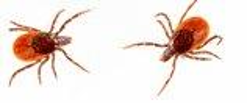
Ticks are tiny parasitic pests that feed off of living hosts such as humans and animals. They are most well-known for transmitting a wealth of harmful diseases and illnesses including Lyme disease. By walking through tall grasses, brush, or lawns that aren’t regularly mowed, you can expose yourself and your pets to tick bites. You may think that ticks only live in the woods and far off in nature, but they can also live within your lawn. That’s why it’s more important than ever that you educate yourself on the kinds of ticks in California and the dangers they pose.
What ticks live in California?
There are 47 species of ticks that are native to California, but there are only a handful that you need to be concerned about. These most common ticks that can transmit disease to humans include the Western blacklegged tick, American dog tick, Pacific Coast tick, wood tick, and the brown dog tick. All of these ticks have the ability to pop up in your yard without warning during tick season, which is spring through early fall in our area.
Ticks do not have wings and they are flat and round. They are small until they feed and become engorged from the blood. These pests also have sharp short legs that they use to help burrow into your skin. You won’t feel them when they land on you, so it’s difficult to identify them. Another issue that many people have with ticks is their speed. They move quickly, and they can jump far distances, so it’s nearly impossible to catch them. If you try to squeeze or squish them, you will think you succeeded until they bounce off your finger and onto something else.
Western Blacklegged Tick
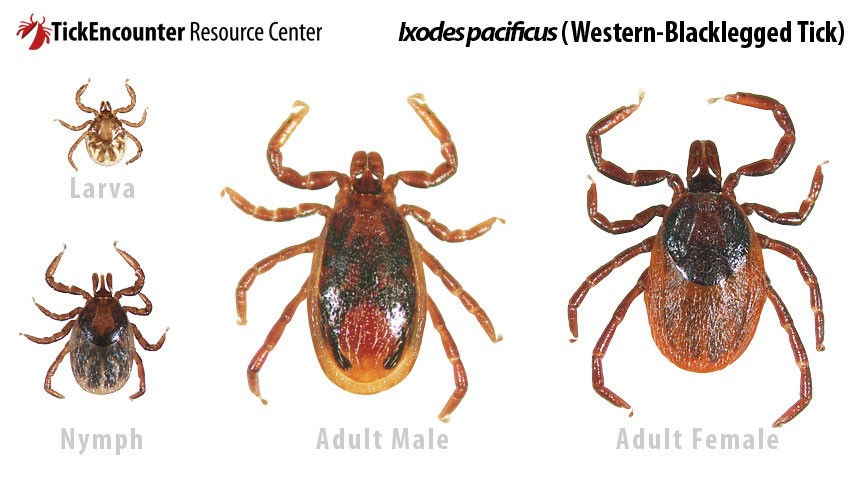
Adult female Western blacklegged ticks can transmit Lyme disease and anaplasmosis to its hosts. They rest on tall blades of grass, playing the waiting game until a host brushes by. When this happens, the tick quickly latches onto a human or animal host and begins feeding. Keeping your grass short can help deter Western blacklegged ticks.
American Dog Tick
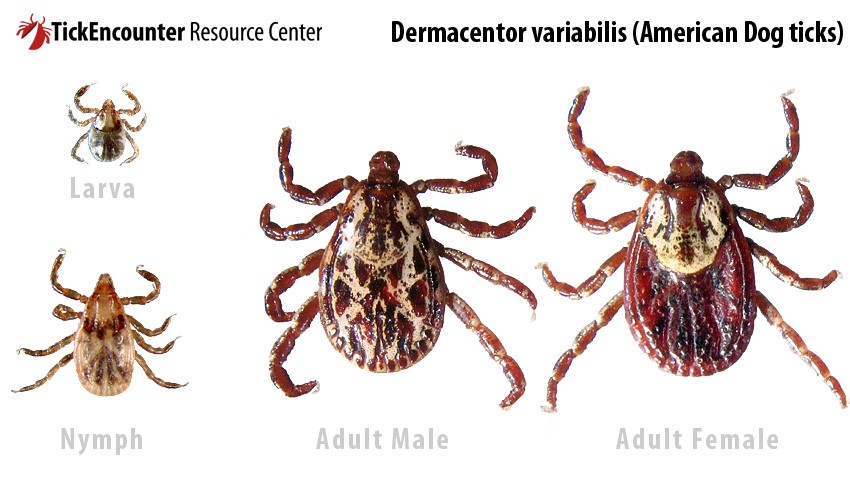
American Dog Ticks are the most frequently encountered tick and are the most likely tick to be found on both pets and humans. These ticks are very active and will travel from their questioning locations into manicured areas. These ticks will readily use humans as a host and are capable of transmitting Rocky Mountain spotted fever.
Pacific Coast Tick
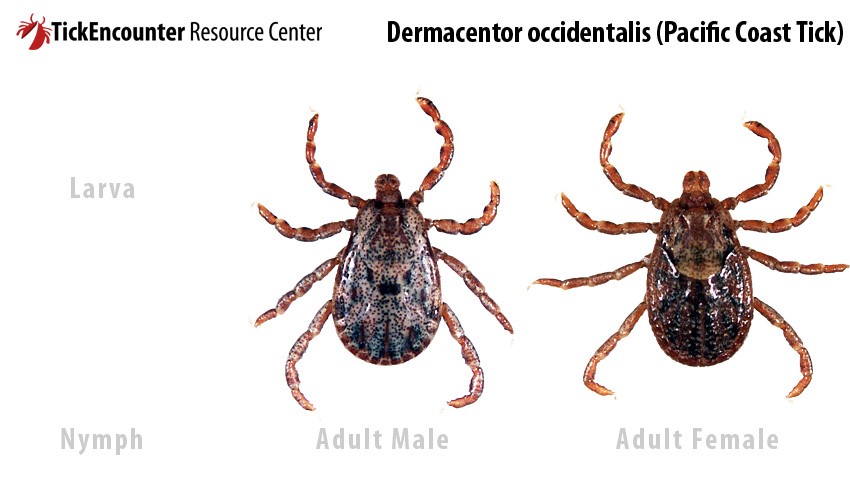
The Pacific Coast tick can transmit Rocky Mountain spotted fever and tularemia. All life stages from nymph to adult can inflict this disease upon humans and animals. You’ll most likely hear about Pacific Coast ticks as they pertain to livestock and wild animals. They live slightly off the beaten path, making them a concern for walks through vegetation with your dog.
Wood Tick
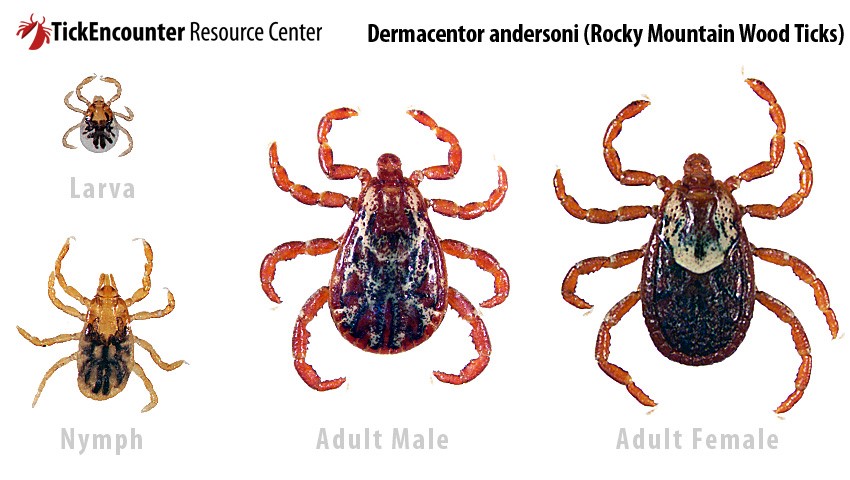
Wood ticks live within vegetation and long grasses where they can hide until a host brushes past. Like all other ticks we’ve gone over today, wood ticks feed off of humans and animals, with the potential to pass on diseases such as Rocky Mountain Spotted Fever.
Brown Dog Tick
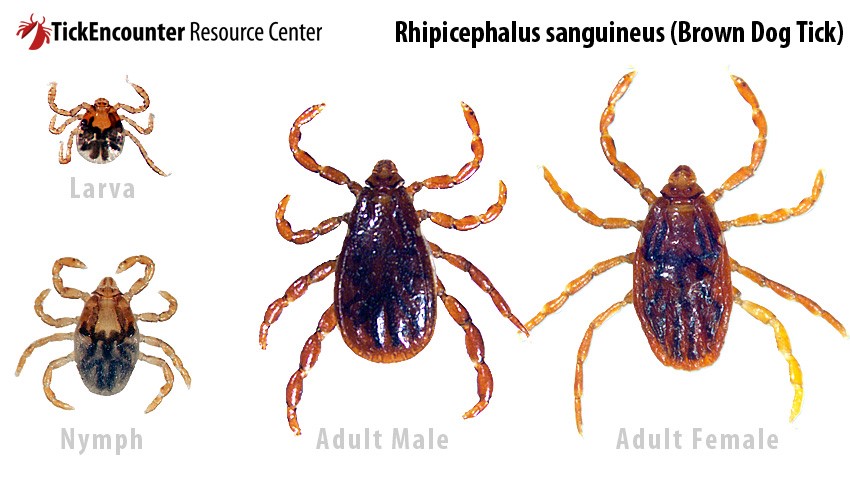
The Brown Dog Tick is, you guessed it, mostly found on dogs. It’s far less likely for humans to be bitten by Brown Dog Ticks, but in the absence of a dog as a host, we’re a suitable second. When the tick finds a dog, they latch on to tight, hidden areas such as under ears or between toes.
The entire life cycle of a Brown Dog Tick can be completed indoors. After feeding on the dog, the tick is brought into the home and crawls into spaces where they are the least likely to be found such as the cracks around baseboards, door frames, and window frames. After hatching, larvae seek out a host and the cycle starts again. Brown Dog Ticks are able to go up to 8 months without feeding, which makes them especially dangerous.
What attracts ticks to my yard?
In our area, tick season begins in late spring and continues into early fall. You are most likely to encounter ticks when walking in an area that is naturally infested with ticks, like tall grass or heavy vegetation. Wildlife that ventures into your yard can leave ticks behind that otherwise were not on your property. While some ticks will venture out into even the best kept lawns, ticks like the Brown Dog Tick can live indoors.
Are ticks dangerous?
You should be concerned about tick bites because they can transmit a multitude of harmful illnesses and diseases.
- Rocky Mountain Spotted Fever – This bacterial disease is fatal and it causes fever, headache, nausea, vomiting, stomach pain and weight loss. RMSF can be transmitted by the American dog tick, brown dog tick, wood tick, and Pacific Coast tick among others.
- hrlichiosis/Canine Ehrlichiosis – We also have to worry about our furry friends. This condition affects humans, but it is most prevalent in dogs. It causes the death of white blood cells, which results in headache, fatigue, and soreness. Brown Dog Ticks carry ehrlichiosis.
- Babesia/Canine Babesia – In most cases, the infected individual does not know they have babesia until symptoms surface weeks or even months later. Symptoms of babesia include, but are not limited to, chills, fever, headaches body aches, nausea, and fatigue. If left untreated, babesia can cause hemolytic anemia, a condition that causes red blood cells to be destroyed and removed from the bloodstream at quicker rate than normal. Babesia can be transmitted by the Brown Dog Tick among others.
- Lyme Disease – Lyme disease is caused by bacterial through a tick bite. Short term complications can include rash, fever, headaches, and extreme fatigue. Long term effects can occur if the problem isn’t addressed quickly. This includes infections within the joints, nervous system, and even the heart. The Western blacklegged tick among others can spread Lyme disease.
How can I prevent ticks from getting into my yard?
To prevent being bit by ticks outdoors, try using repellent that has the active ingredient “DEET”, covering up exposed legs and arms, keeping your lawn short, and regularly checking your pet for ticks. Trim back brush or overgrown ivy that provides hiding places for ticks. Never let piles of leaves sit on your property. Although it may be tempting, never jump into a pile of leaves. Ticks are known to inhabit these areas.
Professional tick control is always your best defense against tick activity in your yard. If you are finding ticks in your yard or want to prevent them from living in your yard, contact AAI Pest Control! Call us or fill out the contact form on this page to get started!
What Are Ticks? Professional Pest Control Services in Tracy CA
Serving
